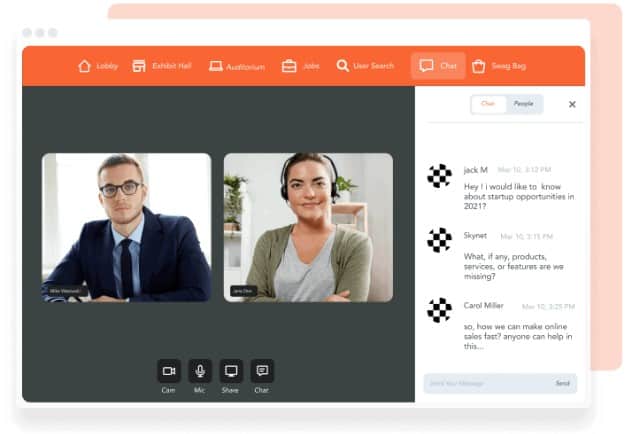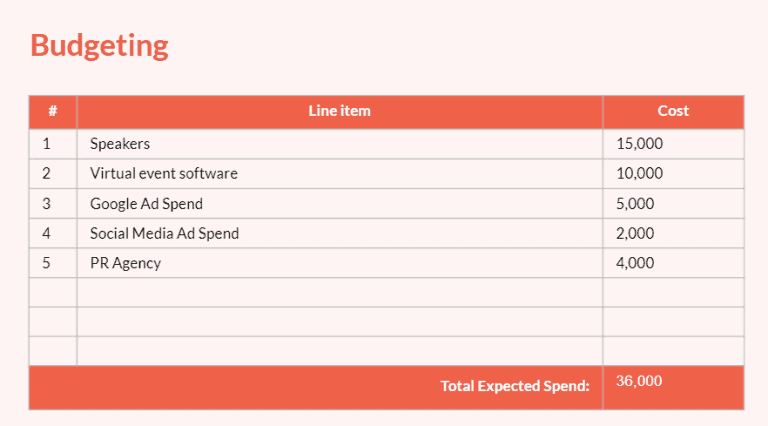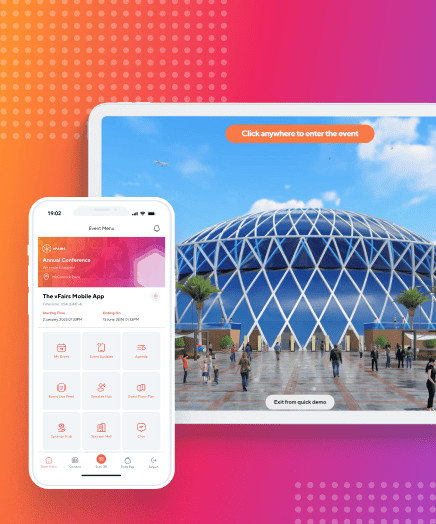Meetings have evolved significantly over time. We’re now having a big debate about whether it’s better to meet in person or online, especially as our world becomes more flexible, tech-savvy, and environmentally conscious. Choosing the right meeting format has become more crucial than ever, with each option offering a unique set of benefits and drawbacks.
In this blog, we delve deep into the pros and cons of an in-person meeting vs virtual. By the end, you’ll be equipped with the insights needed to make an informed choice, tailored to your specific needs.
In-Person Meetings
An in-person meeting refers to a gathering or interaction where participants physically assemble in the same location, such as a conference room, office, or any physical venue. It allows attendees to interact face-to-face, engaging in direct conversations, observing body language, and making eye contact. In-person meetings provide a tangible sense of presence and immediacy
Benefits of In-Person Meetings
1. Face-to-Face Interaction
In-person meetings offer the unique advantage of real, physical presence. Participants can shake hands, make eye contact, and interpret body language, which enhances the quality of communication. These personal touches foster connections that transcend the limitations of digital communication.

2. Building Rapport and Trust
There’s an inherent sense of trust that develops when people share the same physical space. In-person meetings create opportunities for small talk, informal bonding, and personal interactions that lay the foundation for solid professional relationships. Trust and rapport are easier to establish face-to-face.
3. Leveraging Non-Verbal Communication
Words alone can sometimes fall short of conveying the full depth of a message. In-person meetings allow participants to pick up on non-verbal cues such as facial expressions, gestures, and body language. This nuanced communication ensures a deeper and more accurate understanding of the message being conveyed.
Drawbacks of In-Person Meetings
1. Impact of Travel Expenses and Time
One of the significant drawbacks of in-person meetings is the need for physical presence, which often involves substantial travel expenses and time commitments. Travel costs, accommodation, and time away from work can strain budgets and schedules.
2. Limitations in Scheduling Flexibility
Coordinating the schedules of all meeting participants for an in-person meeting can be challenging. Difficulty in accommodating everyone’s availability leads to scheduling conflicts and potential disruptions.
3. Considerations for Environmental Impact
In today’s eco-conscious world, the carbon footprint associated with in-person meetings, especially those involving long-distance travel, raises environmental concerns. The environmental impact of travel is an important consideration for organizations aiming to reduce their carbon emissions.
Virtual Meetings
A virtual meeting is a meeting conducted through digital communication tools and platforms, typically over the Internet. Participants join these meetings remotely from various locations using computers, smartphones, or other internet-connected devices. Virtual meetings can include video conferences, audio conferences, webinars, or any form of online collaboration where attendees interact electronically, rather than being physically present in the same room.

Benefits of Virtual Meetings
1. Accessibility and Convenience
Virtual meetings break down geographical barriers, allowing participants to join from anywhere in the world. This level of accessibility fosters inclusivity and flexibility, making it easier for diverse teams from different locations to collaborate effectively.
2. Cost-Efficiency
Virtual meetings significantly eliminate travel expenses, accommodation costs, and the need to rent venues. Organizations can realize substantial cost savings while still achieving their meeting objectives.
3. Overcoming Geographic Barriers
Virtual meetings eliminate the limitations imposed by physical locations. Whether connecting with clients, partners, or team members, virtual meetings ensure that geography does not impede communication and collaboration.
Drawbacks of Virtual Meetings
1. Navigating the Lack of Physical Presence
One of the challenges of virtual meetings is the absence of face-to-face interaction. While technology facilitates communication, the lack of physical presence can sometimes hinder relationship-building, making it harder to establish trust and rapport.
2. Tackling Technical Challenges
Virtual meetings rely on technology and internet connectivity. Technical glitches, poor internet connections, and software issues can disrupt the flow of virtual meetings, leading to frustration and delays.
3. Addressing Potential Distractions
Virtual meetings often take place in environments like homes or remote workplaces, which can be prone to distractions. Attendees may struggle to stay fully engaged, leading to potential interruptions and reduced productivity.
Key Differences Between In-Person Meeting vs Virtual
When deciding between a physical meeting vs virtual meeting, it’s essential to recognize the distinct advantages and drawbacks of each format. Let’s delve deeper into these key differences to help you make an informed choice:
Communication Dynamics
In-person meetings shine in terms of communication dynamics. They allow for rich, nuanced interactions facilitated by non-verbal cues such as facial expressions, gestures, and body language. This depth in communication enables participants to pick up on subtle cues, facilitating a more profound understanding of the message being conveyed. It’s an ideal setting for sensitive discussions, negotiations, or brainstorming sessions that require a high level of interpersonal communication.
On the other hand, virtual meetings tend to lean towards more concise and direct exchanges. While technology has made it possible to communicate effectively, the absence of physical presence can sometimes limit the depth of interactions. Virtual meetings often necessitate clear and well-structured communication to compensate for the lack of non-verbal cues. They are better suited for straightforward information-sharing and decision-making processes.
- In-person meetings excel in nuanced communication with non-verbal cues, while virtual meetings lean toward concise exchanges, each serving distinct communication needs.
Engagement Levels
The physical presence of participants in in-person meetings naturally fosters higher levels of engagement. Attendees are more likely to be actively involved in discussions, and the dynamic energy of face-to-face interactions promotes spontaneous engagement. This format is particularly effective for team-building activities, workshops, and collaborative problem-solving where active participation is crucial.
Virtual meetings require deliberate strategies to maintain attendee focus and active participation. The absence of physical presence can sometimes lead to distractions, reduced engagement, and passive listening. Meeting organizers often need to employ interactive tools, breakout sessions, and engaging content to keep participants actively involved. While it may require extra effort, virtual meetings can still achieve high levels of engagement with the right virtual event management platform.
- In-person meetings naturally boost engagement through physical presence, whereas virtual meetings demand deliberate strategies to combat distractions and promote active participation
Budget Considerations
In-person meetings often come with higher budget requirements. Travel expenses, including transportation, accommodation, and meals, can add up significantly, especially for meetings involving participants from different locations. Venue rental, audiovisual equipment, and other logistical costs contribute to the overall expenditure.
Virtual meetings are generally more budget-friendly. They eliminate travel-related expenses, saving on transportation, accommodation, and associated costs. Additionally, there is no need to rent physical venues or invest in extensive A/V equipment. Virtual meetings are a cost-effective alternative that can be particularly advantageous when financial resources are limited.
- In-person meetings are costly due to travel, accommodation, and venue expenses, while virtual meetings are budget-friendly, saving on travel and logistics.

Environmental Impact
In-person meetings typically have a higher environmental impact due to travel-related factors. Air and ground transportation, along with accommodations, can generate significant carbon emissions. This aspect of in-person meetings has become a point of concern for organizations striving to minimize their environmental footprint.
Whereas, virtual meetings have a distinct advantage in terms of environmental impact. By reducing or eliminating the need for travel, they contribute to lower carbon emissions. Moreover, all content is digital, which reduces paper wastage. This aligns with sustainability goals and promotes environmentally responsible practices. Organizations committed to reducing their carbon footprint often choose virtual meetings as part of their sustainability initiatives. vFairs has also launched the Green and Global initiative to assist organizations in hosting environmentally friendly events and mitigating the harmful impacts of climate change.
- In-person meetings generate higher carbon emissions from travel, while virtual meetings are more environmentally friendly, aligning with sustainability goals.

What Should You Choose?
Choosing between virtual vs in-person meetings is not a one-size-fits-all decision. To make the right choice, you need to consider several crucial factors that align with your specific objectives and constraints. Here’s an in-depth look at what you should take into account:
Defining the Meeting’s Purpose and Goals
Begin by clearly defining the purpose and objectives of your meeting. Ask yourself:
- What is the primary goal of this meeting? Is it for information sharing, decision-making, relationship-building, brainstorming, training, or something else?
- Are there specific outcomes or deliverables expected from this meeting?
- How critical is the need for interpersonal communication and non-verbal cues in achieving the meeting’s goals?
- Does the nature of the discussion require confidentiality or sensitivity that might be better suited to an in-person setting?
Understanding the meeting’s purpose and goals is the foundation upon which you can build the rest of your decision-making process.
Considering Attendees Locations
The geographical location of your meeting participants plays a significant role in your decision. Ask yourself:
- Where are your attendees located? Are they spread out across different cities, states, or even countries?
- Are there logistical challenges or visa requirements that attendees might face if an in-person meeting is chosen?
- Does the meeting involve external clients, partners, or stakeholders who may have their own constraints?
The location and availability of your participants can heavily influence the feasibility and practicality of either meeting format.
Navigating Budget Constraints
Budget considerations are a critical aspect of your decision-making process. Take into account:
- What is the budget allocated for this meeting, and how does it align with the costs associated with your chosen format?
- Are there cost savings associated with a virtual meeting, such as reduced travel, accommodation, and venue expenses?
- Will the budget accommodate any additional expenses related to technology, virtual meeting platforms, or engagement tools for a virtual meeting?
Balancing your budgetary constraints with your meeting’s objectives is essential to ensure that your chosen format is financially sustainable.
Guiding the Decision-Making Process
Once you’ve gathered information and considered the factors mentioned above, it’s essential to establish a structured decision-making process. This might involve:
- Creating a decision matrix that quantifies and ranks the importance of each factor based on your meeting’s unique characteristics.
- Engaging key stakeholders and decision-makers to ensure alignment with organizational objectives and policies.
- Conducting a cost-benefit analysis that weighs the financial implications of each format against the meeting’s expected outcomes.
- Seeking feedback and input from potential attendees to gauge their preferences and concerns.
Key Takeaway
In comparison to meeting in-person vs online, in-person meetings offer an irreplaceable personal touch. Virtual meetings, on the other hand, offer convenience and accessibility. Your choice should reflect your unique goals, constraints, and values. Ultimately, it’s not about whether in-person or virtual meetings are better, it’s about choosing the format that best serves your audience’s needs!
FAQs
Why in-person meetings are better than virtual ones?
In-person meetings excel over virtual ones when deepening relationships, handling complex discussions, and fostering team building and brainstorming sessions. They provide the crucial human touch, non-verbal cues, and immediate interaction needed for these aspects of effective communication and collaboration.
What are the benefits of in-person meetings vs virtual?
In-person meetings excel in scenarios that require complex discussions, relationship cultivation, and team-building. In contrast, virtual meetings provide accessibility and cost-efficiency, overcoming geographical barriers and reducing travel-related expenses.
What are the benefits of virtual meetings vs in-person?
Virtual meetings are highly convenient, eliminating the need for travel, reducing costs, and accommodating participants from diverse locations. Virtual meetings also promote inclusivity and flexibility, making it easier to schedule and join discussions.





